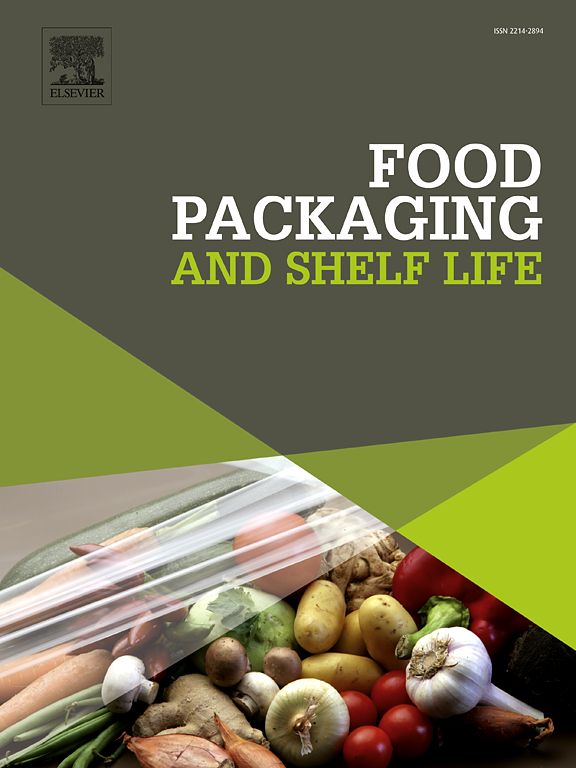Cellulose nanofibrils (CNF) as a conjugate carrier and its potential as a high-barrier, UV-blocking, and low-intensity visible light-responsive antimicrobial packaging material
IF 10.6
1区 农林科学
Q1 FOOD SCIENCE & TECHNOLOGY
引用次数: 0
Abstract
Food quality deteriorates due to bacteria contamination, hence the need for antimicrobial packaging. Reactive oxygen species (ROS) have drawn interest as an antimicrobial strategy through combination of light irradiation, oxygen, and photosensitive components. In this study, titanium dioxide (TiO2) and tetrakis(4-carboxyphenyl)porphyrin (TCPP) were combined to acquire conjugates with visible-light responsive photosensitivity. The conjugate was next incorporated into a low-pressure homogenized (0–25 cycles) cellulose nanofibril (CNF) matrix to address the notorious self-aggregation/quenching tendency. The novel, antibiotics-absent antimicrobial films successfully inactivated Escherichia coli completely after 72 h under 6000 lux-light irradiation, on top of the UV-A/B/C total blocking performance. Post-homogenization, surface smoothness (Sa, 2.5 from 7.0 μm), mechanical (TS, 44 from 25 MPa; TM, 5 from 3 MPa; EAB, 11 from 9 %), thermal (Td,5 %, 295 from 100 °C; %W at 700 °C, 49 from 17 %), and contact angle (0–60 s) properties were also improved, confirming the influence of enhanced fibrillation and subsequent inter/intra-molecular hydrogen bonding. Low oxygen permeability at 50 %RH (0.05 cc.μm/m2.day.kPa) was confirmed, comparable to reference values of several commercial high-barrier polymers (e.g., ethylene-vinyl alcohol brand of EVAL™ F, 0.05 cc.μm/m2.day.kPa). This work ultimately certified CNF’s capability as a natural and biodegradable carrier of conjugate, as also confirmed morphologically by the even dispersion of conjugate. These findings showcased the promising potential for a myriad of antibacterial packaging applications even under considerably-low intensities of visible light.
纤维素纳米原纤维(CNF)作为一种共轭载体及其作为高阻隔、紫外线阻隔和低强度可见光响应的抗菌包装材料的潜力
食品质量因细菌污染而恶化,因此需要抗菌包装。活性氧(ROS)作为一种结合光照射、氧和光敏成分的抗菌策略已引起人们的兴趣。在本研究中,二氧化钛(TiO2)和四(4-羧基苯基)卟啉(TCPP)结合获得具有可见光响应光敏性的偶联物。然后将该偶联物加入低压均质(0-25循环)纤维素纳米纤维(CNF)基质中,以解决臭名昭著的自聚集/猝灭倾向。这种新型的不含抗生素的抗菌膜在6000强光照射72 h后,在UV-A/B/C总阻断性能的基础上,成功地完全灭活了大肠杆菌。匀浆后,表面光滑度(Sa, 2.5 from 7.0 μm),力学(TS, 44 from 25 MPa;TM, 5从3 MPa;EAB, 11从9 %),热(Td,5 %,295从100 °C;%W在700 °C, 49从17 %),接触角(0-60 s)性能也得到改善,证实了增强的纤维性和随后的分子间/分子内氢键的影响。在50 %RH (0.05 cc.μm/m2.day.kPa)下的低氧渗透率被证实,与几种商业高阻隔聚合物的参考值相当(例如,EVAL™F的乙烯-乙烯醇品牌,0.05 cc.μm/m2.day.kPa)。这项工作最终证明了CNF作为一种天然的、可生物降解的共轭物载体的能力,也证实了共轭物的均匀分散。这些发现表明,即使在相当低的可见光强度下,抗菌包装的应用也有很大的潜力。
本文章由计算机程序翻译,如有差异,请以英文原文为准。
求助全文
约1分钟内获得全文
求助全文
来源期刊

Food Packaging and Shelf Life
Agricultural and Biological Sciences-Food Science
CiteScore
14.00
自引率
8.80%
发文量
214
审稿时长
70 days
期刊介绍:
Food packaging is crucial for preserving food integrity throughout the distribution chain. It safeguards against contamination by physical, chemical, and biological agents, ensuring the safety and quality of processed foods. The evolution of novel food packaging, including modified atmosphere and active packaging, has extended shelf life, enhancing convenience for consumers. Shelf life, the duration a perishable item remains suitable for sale, use, or consumption, is intricately linked with food packaging, emphasizing its role in maintaining product quality and safety.
 求助内容:
求助内容: 应助结果提醒方式:
应助结果提醒方式:


